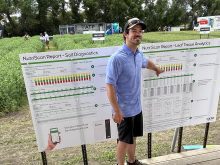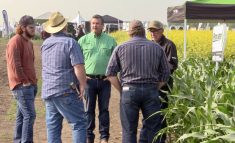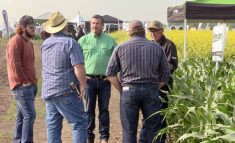In many situations enhanced efficiency fertilizers do not boost yields because there is already sufficient nitrogen in the system
This is the third story of a four-part series on enhanced efficiency fertilizer. Links to other stories in this series are below.
There may be an opportunity to increase or preserve yields with enhanced efficiency fertilizers (EEF), but farmer adoption remains low in Canada. The reasons could be inconsistent results, the wrong sales pitch or both.
“The problem is we’ve been selling them for emissions reductions, but farmers don’t get paid to reduce emissions,” said Richard Farrell, a University of Saskatchewan soil scientist. “They get paid for the crop they produce. So there has to be an agronomic benefit.”
Read Also

Research looks to control flea beetles with RNAi
A Vancouver agri-tech company wants to give canola growers another weapon in the never-ending battle against flea beetles.
Related stories in this series:
- Part 1 – Enhanced efficiency adoption is low
- Part 2 – How do Enhanced Efficiency Fertilizers work?
- Part 4 – Can you cut fertilizer rates with EEFs?
EEFs can only increase yield or preserve yield if there is sufficient leakage of N or if there isn’t enough N available to the plant.
“You have to have a situation where there are large (potential) losses by volatilization or large losses by leaching… If there are no losses, you’re not going to see anything (yield benefit),” said Tom Bruulsema, chief scientist with the International Plant Nutrition Institute Canada.
In Canada, a large amount of N leakage is more likely in southern Ontario and Quebec, as those geographies are warmer and receive more precipitation.
“The wetter areas of the Prairies are where you have the most impact from using an enhanced efficiency fertilizer,” Bruulsema said.
There may be circumstances where nitrogen losses are significant and an EEF could protect yield, but Canadian soil scientists have struggled to detect yield gains on the Prairies.
Mario Tenuta, of the University of Manitoba, published a paper in Agronomy Journal in June of 2023, comparing conventional urea to urea with a dual inhibitor (SuperU) on canola fields.
Tenuta and his team used multiple placement methods for the fertilizer — broadcast-incorporated, shallow-banded, and deep-banded, and repeated the experiments on multiple fields in southern Manitoba.
The research was conducted from 2014 to 2016.
They found that SuperU cut nitrous oxide emissions but didn’t increase canola yield.
“SuperU was effective in retaining soil N in the NH4+ form longer and therefore provided more opportunities for crops to uptake NH4+ and reduce losses through N2O emissions. As SuperU reduced emissions for all placements, including sub-surface banded treatments,” the paper says.
But there were few benefits to yield, at 100 per cent nitrogen rates.
“This is not surprising, as N rates were at provincial guideline recommendations based on soil tests,” the paper says. “Thus, N rates would be above or at the top end of the N response curve for yield with losses of N as N2O and NH3 not greatly affecting crop N availability.”
In many situations, EEFs don’t boost yields because there’s sufficient nitrogen in the “system” and available to the plant, said Craig Drury, a soil bicochemist with Agriculture Canada in Harrow, Ont., who studies 4R nitrogen management in corn.
“In those situations where you have excess N, if you’ve decreased losses… you’re not going to see a yield increase.”
Nonetheless, Drury did measure yield gains in an Ontario study, on corn, published in the Journal of Environmental Quality in 2017.
The research compared broadcast urea to broadcast urea with a urease inhibitor and broadcast urea with a dual inhibitor.
The scientists also had trials with injection of urea ammonium nitrate (UAN), versus injecting UAN with a single or dual inhibitor.
In one year of the experiment, a massive amount of the broadcast urea was lost to the atmosphere. About 50 per cent (64 kg/Ha) of the applied N volatilized as ammonia.
Corn yields were higher in the trials with EEFs, as the inhibitors reduced NH3 leakage.
Yields increased five per cent with broadcast urea and a dual inhibitor, compared to broadcast urea. Yields were seven per cent higher with injected UAN and a dual inhibitor, compared to injected UAN.
A 50 per cent loss of applied nitrogen could be a rare occurrence.
Still, EEFs could be a valuable tool for risk management. Something that prevents nitrogen losses in years with extreme weather or conditions that exacerbate N leakage.
“Some places like Central Canada, areas in Manitoba, do frequently have these heavier storms that cause wet conditions during the growing season. In particular, after nitrogen is applied,” Drury said.
“In some respects, those products (EEFs) are like an insurance.”
The On Farm Climate Action Fund shares a similar message, saying that managing risk is reason to try an EEF.
That may appeal to some growers, but Canadian soil scientists are studying another way to reap the agronomic benefits of the products.
The final story of this series examines if EEFs allow farmers to cut fertilizer rates without a yield penalty.


















